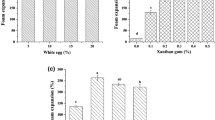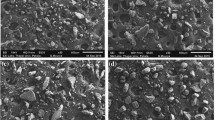Abstract
In this study, the grinding kinetics and the flowability of balloon flowers (BFs) with various moisture contents (8, 12, and 20%) were determined. Three semi-empirical grinding models (Bond, Kick, and Rittinger) were applied to describe the BFs’ grinding process. A lower moisture content resulted in a decreased grinding constant value (Bond’s index). Based on the kinetics of particles during grinding, a sigmoid model was developed which successfully described changes in the particle sizes of BFs with various moisture contents during the grinding process except for smaller ones (< 0.60 mm) with a high moisture content (20%). The flow function at different particle sizes was not consistently correlated with results regarding the internal friction angle. This might be due to different particle shapes and sizes of BFs. The poorest flowability was observed for BF powder with the smallest particle size.



Similar content being viewed by others
References
Tada A, Kaneiwa Y, Shoji J, Shibata S. Studies on the saponins of the root of Platycodon grandiflorum A. De Candolle. I. Isolation and the structure of platycodin-D. Chem. Pharm. Bull. 23: 2965–2972 (1975)
Indira TN, Bhattacharya S. Grinding characteristics of some legumes. J. Food Eng. 76: 113–118 (2006)
McCabe WL, Smith JC, Harriott P. Unit Operations of Chemical Engineering, Fifth ed. McGraw-Hill Inc., Singapore, pp. 963–964 (1993)
Dziki D. The crushing of wheat kernels and its consequence on the grinding process. Powder Technol. 185: 181–186 (2008)
Walde SG, Balaswamy K, Velu V, Rao DG. Microwave drying and grinding characteristics of wheat (Triticum aestivum). J. Food Eng. 55: 271–276 (2002)
Velu V, Nagender A, Rao PGP, Rao DG. Dry milling characteristics of microwave dried maize grains (Zea mays L.). J. Food Eng. 74: 30–36 (2006)
Lee YJ, Lee MG, Yoon WB. Effect of seed moisture content on the grinding kinetics, yield and quality of soybean oil. J. Food Eng. 119: 758–764 (2013)
Barbosa-Ćanovas GV, Ortega-Rivas E, Juliano P, Yan H. Food Powders: Physical Properties, Processing, and Functionality. Kluwer Academic, New York (2005)
Fu X, Huck D, Makein L, Armstrong B, Willen U, Freeman T. Effect of particle shape and size on flow properties of lactose powders. Particuology 10: 203–208 (2012)
Teunou E, Fitzpatrick JJ, Synnott EC. Characterisation of food powder flowability. J. Food Eng. 39: 31–37 (1999)
Fitzpatrick JJ, Barringer SA, Iqbal T. Flow property measurement of food powders and sensitivity of Jenike’s hopper design methodology to the measured values. J. Food Eng. 61: 399–405 (2004)
Rhodes M. Introduction to Particle Technology, second ed. Wiley, England (2008)
AOAC. Official methods of analysis. 16th ed. Association of Official Analysis Chemists, Washington DC, USA, pp. P777–P784 (2005)
Djantou EB, Mbofung CM, Scher J, Desobry S. A modelling approach to determine the effect of pre-treatment on the grinding ability of dried mangoes for powder production (Mangifera indica var Kent). J. Food Eng. 80: 668–677 (2007)
Jenike AW. Storage and flow of solids. Bulletin 123. Engineering Experiment Station, University of Utah (1964)
Lee YJ, Yoo JS, Yoon WB. Grinding characteristics of black soybeans (Glycine max) at varied moisture contents: particle size, energy consumption, and grinding kinetics. Int. J. Food Eng. 10: 347–356 (2014)
Dziki D. Effect of preliminary grinding of the wheat grain on the pulverizing process. J. Food Eng. 104: 585–591 (2011)
Pan Z, Tangratanavalee W. Characteristics of soybeans as affected by soaking conditions. LWT Food Sci. Tech. 36: 143–151 (2003)
Schulze D. Powders and Bulk Solids: Behavior, Characterization, Storage and Flow. Springer, Heidelberg (2008)
Teunou E, Fitzpatrick JJ. Effect of storage time and consolidation on food powder flowability. J. Food Eng. 43: 97–101 (2000)
Pai DA, Okos MR. Predicting the density and tensile strength of viscoelastic soy powder compacts. J. Food Eng. 116: 184–194 (2013)
Acknowledgements
This study has been worked with the support of a research grant of Kangwon National University in 2016.
Author information
Authors and Affiliations
Corresponding author
Rights and permissions
About this article
Cite this article
Moon, J.H., Yoon, W.B. Effect of moisture content and particle size on grinding kinetics and flowability of balloon flower (Platycodon grandiflorum). Food Sci Biotechnol 27, 641–650 (2018). https://doi.org/10.1007/s10068-017-0291-z
Received:
Revised:
Accepted:
Published:
Issue Date:
DOI: https://doi.org/10.1007/s10068-017-0291-z




